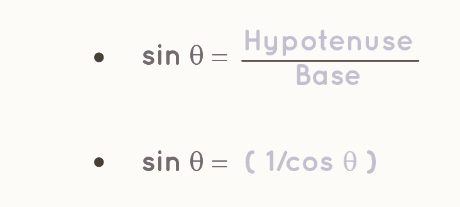
Secant Formula: In a right-angled triangle, there are three sides: the hypotenuse, the perpendicular, and the base. The hypotenuse is the longest side, and it is opposite the right angle. The perpendicular is the side that forms a right angle with the base. The base is the side on which the right angle is located.
The secant (denoted as 'sec') of an angle in a right-angled triangle is defined as the ratio of the length of the hypotenuse to the length of the adjacent side. In mathematical terms, if θ is an angle in the right-angled triangle, then the secant of θ is given by:
sec(θ) = hypotenuse/adjacent side

The secant function is derived from the reciprocal of the cosine function. In other words, sec(θ) = 1 / cos(θ). It's important to note that the secant function approaches infinity whenever the cosine function is equal to zero (cos(θ) = 0). This occurs when θ is a right angle or any multiple of it (90 degrees, 270 degrees, etc.).
What is Secant Formula?
Right-Angled Triangle: In a right-angled triangle, there are three sides: the hypotenuse, the perpendicular side (opposite the angle), and the adjacent side (which is the height).
The hypotenuse is the longest side, the side opposite the right angle is the perpendicular side and the side where both the hypotenuse and perpendicular side rest is the adjacent side.
Secant Function: The secant function in a right triangle is defined as the ratio of the length of the hypotenuse to the length of the adjacent side. Mathematically, sec(θ) = H/B, where B is the base and H is the hypotenuse.
The secant is the reciprocal of the cosine function, i.e., sec(θ) = 1/cos(θ).
Secant Formula: The secant formula is related to the Pythagorean theorem and can be expressed as Sec 2 θ = 1 + tan 2 θ.
This formula is useful and similar to the squared relationship between the sine (sin(θ)) and cosine (cos(θ)) functions, where sin 2 θ + cos 2 θ = 1.
Secant Formula Application
The secant formula, which relates the secant of an angle in a right-angled triangle to the lengths of its sides, has various practical applications in different fields. Here are some areas where the secant formula finds application:
- Engineering and Architecture: Architects and engineers use the secant formula to calculate angles and dimensions in construction and design projects. It helps in determining angles for sloped surfaces, such as roofs and ramps.
- Trigonometry and Mathematics Education: The secant formula is an important concept in trigonometry and mathematics education. It is used to teach students about trigonometric functions, relationships between angles and sides, and how to solve problems involving right-angled triangles.
- Navigation and Surveying: In navigation, especially for sailors and pilots, the secant formula can be used to calculate angles related to navigation and to determine distances between locations.
- Physics and Engineering Mechanics: The secant formula is useful in physics and engineering when dealing with the angular relationship of forces, vectors, and mechanical systems.
- Geographic Information Systems (GIS): GIS professionals use trigonometric functions like the secant to model and analyze spatial data, such as elevation, slope, and line-of-sight visibility.
- Astronomy and Astrology: In astronomy, the secant formula can be applied to calculate the apparent altitude of celestial objects as observed from different locations on Earth.
In these fields, the secant formula plays a crucial role in solving practical problems, making accurate measurements, and understanding the relationships between angles and sides in right-angled triangles. It is a fundamental tool for professionals and students working in a wide range of disciplines.
Secant Formula Examples
Example 1: Finding the Secant of an Angle
Suppose we have a right-angled triangle with an angle θ, and we know the lengths of the base (B) and the hypotenuse (H). Find the secant of angle θ.
Given:
Base (B) = 4 units
Hypotenuse (H) = 5 units
Using the secant formula:
sec(θ) = H/B
sec(θ) = 5/4
So, the secant of angle θ is 5/4.
Example 2: Finding the Secant of an Angle using Pythagoras Suppose we have a right-angled triangle with an angle θ, and we know the length of the adjacent side (A) and the perpendicular side (P). Find the secant of angle θ using Pythagoras' theorem.
Given:
Adjacent side (A) = 3 units
Perpendicular side (P) = 4 units
First, use Pythagoras' theorem to find the hypotenuse (H):
H² = A² + P²
H² = 3² + 4²
H² = 9 + 16
H² = 25
H = √25
H = 5 units
Now, find the secant of angle θ using the secant formula:
sec(θ) = H/A
sec(θ) = 5/3
So, the secant of angle θ is 5/3.
Example 3: Finding the Secant of an Angle using Trigonometric Functions Suppose we have a right-angled triangle with an angle θ, and we know the cosine (cos(θ)) and sine (sin(θ)) values of the angle. Find the secant of angle θ.
Given:
cos(θ) = 0.6
sin(θ) = 0.8
Use the relationship between trigonometric functions:
sec(θ) = 1/cos(θ)
sec(θ) = 1/0.6
sec(θ) = 5/3
So, the secant of angle θ is 5/3.
Example 4: Finding the Secant of a Right Angle In a right-angled triangle, one of the angles is 90 degrees (π/2 radians). Find the secant of a right angle.
Since the right angle is 90 degrees, the cosine of a right angle is 0 (cos(90°) = 0). Therefore, using the secant formula:
sec(90°) = 1/cos(90°)
sec(90°) = 1/0
sec(90°) is undefined (since division by zero is undefined).
So, the secant of a right angle (90 degrees) is undefined.
These examples demonstrate how to use the secant formula to find the secant of different angles in right-angled triangles, whether you have information about the sides or trigonometric values of the angle.
| Related Links | |
| Product to Sum Formula | Profit Margin Formula |
| Pythagorean Triples Formula | Quadratic Interpolation Formula |
Secant Formula FAQs
Q1. What is the secant formula in trigonometry?
Q2. How is the secant function related to the cosine function?
Q3. What happens when the cosine of an angle is zero in the secant formula?
Q4. How can the secant formula be applied in practical situations?










